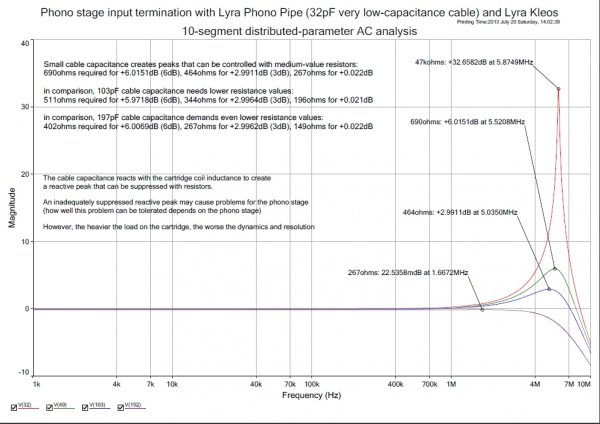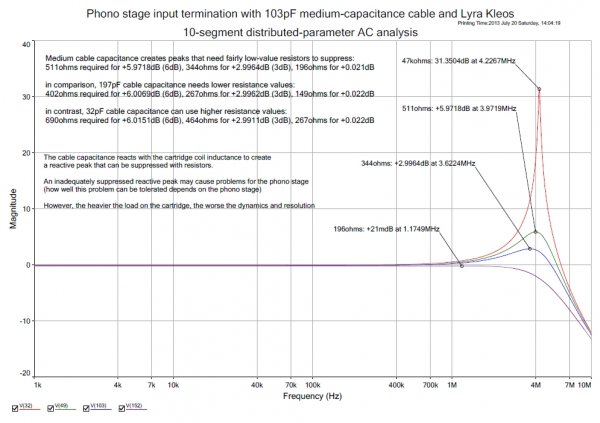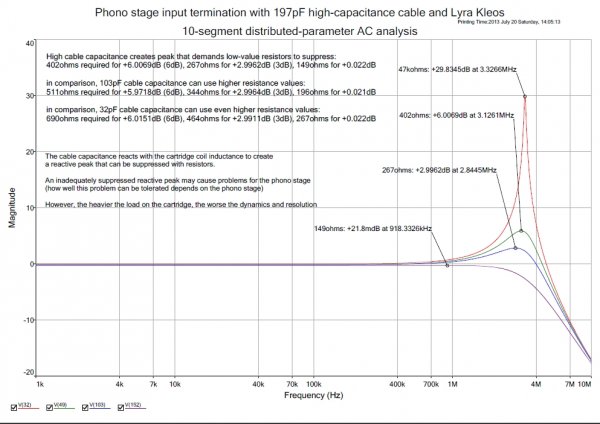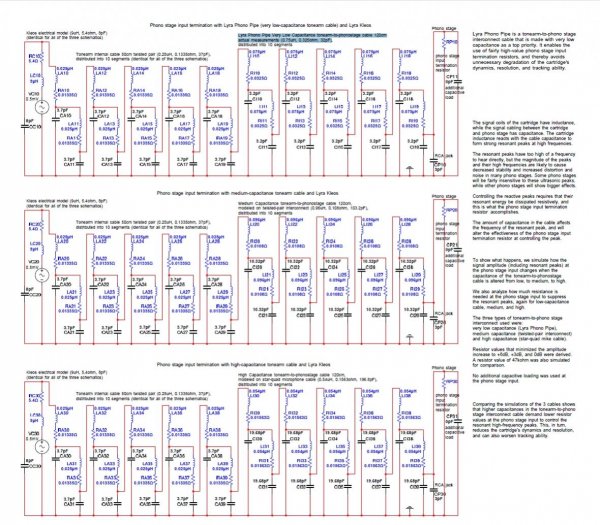Another thing to consider is that inductance is part of it as well. If you use a low capacitance cable that has high inductance then you gain nothing. Ideally you want a cable that that is low capacitance and inductance. I've read that in cable design you usually sacrifice one for the other, although some designs can have both low inductance and capacitance.
Cartridge Loading- A Misnomer
- Thread starter BruceD
- Start date
You are using an out of date browser. It may not display this or other websites correctly.
You should upgrade or use an alternative browser.
You should upgrade or use an alternative browser.
I just ordered a Cardas Clear Phono cable to try out. I'm sure it will be better than the stock cable!
congrats on your new 'table. unless SME did an about face recently, the pin assignment on their DIN connection reverses the +/- signal compared to others like Graham, it wont be a problem if your system inverts phase somewhere else or can be reversed with the flick of a switch. if you still can, you might want to confirm Cardas' pin assignment before they build your cable.
congrats on your new 'table. unless SME did an about face recently, the pin assignment on their DIN connection reverses the +/- signal compared to others like Graham, it wont be a problem if your system inverts phase somewhere else or can be reversed with the flick of a switch. if you still can, you might want to confirm Cardas' pin assignment before they build your cable.
That is good to know...the sme DIN wiring quirk. Coming from the other side one could call Graham's DIN config a quirk. Having to use a phase switch is not optimal.
congrats on your new 'table. unless SME did an about face recently, the pin assignment on their DIN connection reverses the +/- signal compared to others like Graham, it wont be a problem if your system inverts phase somewhere else or can be reversed with the flick of a switch. if you still can, you might want to confirm Cardas' pin assignment before they build your cable.
You can just switch the pins on the cartridge to correct for it.
You can just switch the pins on the cartridge to correct for it.
that's right, unless you're quasi-OCD like me and the color of the tags have to match the liitle colored donuts on the cartridge pins
I have conducted similar investigations as Jim Hagerman, but using more complex cartridge and cable models that are derived from real-world measurements.
Based on these investigations, I authored a document package that was originally created as a white paper to support Lyra's PhonoPipe, a low-capacitance twin-axial phono cable that we started offering from the latter half of last year (may not be available in all markets). However, the focus of the document package is almost completely on the various electrical parameters and the effects that they cause, so any cable of similarly low capacitance should demonstrate the benefits mentioned in the documents.
I wish that I could attach the documents to this post (everything has been zipped into a single archive of 253kB), but I don't know how. Instead, I am willing to send the documents to anyone would like to study this. Just send me a PM with your email address.
Or if a What's Best moderator can help me attach the 253kB zip archive to a post, that would also be good.
Once more people have a chance to study my documentation, and have a chance to play around with the calculators on Jim Hagerman's website, it should be possible to have more meaningful, in-depth discussions about this topic.
kind regards, jonathan
PS. Myles, the Kubotek Haniwa is another design by Matsudaira, and uses the same high performance permeable core materials found in the Air Tight and My Sonic Labs designs.
PPS. Low-impedance MC cartridges are not-very-efficient electrical generators that have little reason to care about how they are loaded (unless the loading value starts to approach the cartridge's internal impedance). It is the phono stage that is far more likely to complain about capacitive loading.
Thanks Jonathan, met Matsudaira at CES a couple of years ago. Unfortunately, my Japanese is non-existent (hey English is a struggle at times!), his English is not very good and the translator lost things in the translation. So unfortunately, I didn't get a lot out the discussion
that's right, unless you're quasi-OCD like me and the color of the tags have to match the liitle colored donuts on the cartridge pinskidding aside, its one less thing to remember if everything is matched from the gitgo.
Koetsu has no colored tags on the cart pins (to avoid OCD) lol
So let me get this straight... SME is the only one that reverses +/- ??
Unless you get a DIN made for the SME pinout, you need to reverse the cartridge leads?
Unless you get a DIN made for the SME pinout, you need to reverse the cartridge leads?
So let me get this straight... SME is the only one that reverses +/- ??
Unless you get a DIN made for the SME pinout, you need to reverse the cartridge leads?
Yes.
It dawned on me that prob half the recordings are out of phase anyways and concerns about reversed +/- are prob all for naught.
Yes.
It dawned on me that prob half the recordings are out of phase anyways .
really ? Any well known examples ? Maybe I should play with my phase invert on the phono pre.
Yes.
It dawned on me that prob half the recordings are out of phase anyways and concerns about reversed +/- are prob all for naught.
Don't you mean reversed polarity?
JCarr's research documents
I got permission from Jonathan to post his documents (Jonathan, PNG gets down-converted to really small JPGs by the WBF software), so that everyone can draw their own conclusions. Things to keep in mind, in the last document (Kleos/cable/phono electrical model), the operating parameters are:




What these tell me (among other things) is that, all else being equal, changing just the interconnecting cable (each of which has a different capacitance characteristic), changes the optimal resistive load; and if you can afford to bring up that peak in the MHz to something <10dB then you can bring up resistive loading to about 500-1K ohms even with a highly-capacitive cable; and finally, you are not really affecting the audible high frequencies with any resistive load shown. Finally, Jonathan's cable has really low capacitance and inductance (compare with Nordost's Odin, for example - Jonathan's much better, wrt capacitance, but much higher inductance).
I got permission from Jonathan to post his documents (Jonathan, PNG gets down-converted to really small JPGs by the WBF software), so that everyone can draw their own conclusions. Things to keep in mind, in the last document (Kleos/cable/phono electrical model), the operating parameters are:
- Kleos electrical model (9uH, 5.4ohm, 8pF)
- Lyra Phono Pipe Very Low Capacitance tonearm-to-phonostage cable 120cm actual measurements (0.75uH, 0.325ohm, 32pF)




What these tell me (among other things) is that, all else being equal, changing just the interconnecting cable (each of which has a different capacitance characteristic), changes the optimal resistive load; and if you can afford to bring up that peak in the MHz to something <10dB then you can bring up resistive loading to about 500-1K ohms even with a highly-capacitive cable; and finally, you are not really affecting the audible high frequencies with any resistive load shown. Finally, Jonathan's cable has really low capacitance and inductance (compare with Nordost's Odin, for example - Jonathan's much better, wrt capacitance, but much higher inductance).
Don't you mean reversed polarity?
not one channel to another but 180 degrees out of phase. if you're familiar with clark Johnson's book "the wood effect" its covered there.
And here's an interesting comment from Ortofon to me (in a private discussion with them) - it clearly goes against what Jonathan and I have said:
[FONT=&]Playing with the input impedance means also playing with the sound character. The influence of the load impedance on the differences in sound is caused by the change of the crosstalk levels and the amplitude raise at the resonance frequency. The lower the load impedance, the higher the current and the more dynamic the sound.[/FONT]
I don't agree with this comment that the sound is more dynamic with lower load impedance (higher current); what you don't want is higher current coming out of the coils, because of the opposing force and Lenz's law postulated in previous posts. I still think a cartridge must be primarily a voltage generator with as little current as possible.
I would love to see Jonathan, Nick and Ortofon battle this out...
[FONT=&]Playing with the input impedance means also playing with the sound character. The influence of the load impedance on the differences in sound is caused by the change of the crosstalk levels and the amplitude raise at the resonance frequency. The lower the load impedance, the higher the current and the more dynamic the sound.[/FONT]
I don't agree with this comment that the sound is more dynamic with lower load impedance (higher current); what you don't want is higher current coming out of the coils, because of the opposing force and Lenz's law postulated in previous posts. I still think a cartridge must be primarily a voltage generator with as little current as possible.
I would love to see Jonathan, Nick and Ortofon battle this out...
And here's an interesting comment from Ortofon to me (in a private discussion with them) - it clearly goes against what Jonathan and I have said:
[FONT=&]Playing with the input impedance means also playing with the sound character. The influence of the load impedance on the differences in sound is caused by the change of the crosstalk levels and the amplitude raise at the resonance frequency. The lower the load impedance, the higher the current and the more dynamic the sound.[/FONT]
I don't agree with this comment that the sound is more dynamic with lower load impedance (higher current); what you don't want is higher current coming out of the coils, because of the opposing force and Lenz's law postulated in previous posts. I still think a cartridge must be primarily a voltage generator with as little current as possible.
I would love to see Jonathan, Nick and Ortofon battle this out...
Maybe it could be decided by doing some vinyl rips and then comparing the files?
And here's an interesting comment from Ortofon to me (in a private discussion with them) - it clearly goes against what Jonathan and I have said:
[FONT=&]Playing with the input impedance means also playing with the sound character. The influence of the load impedance on the differences in sound is caused by the change of the crosstalk levels and the amplitude raise at the resonance frequency. The lower the load impedance, the higher the current and the more dynamic the sound.[/FONT]
I don't agree with this comment that the sound is more dynamic with lower load impedance (higher current); what you don't want is higher current coming out of the coils, because of the opposing force and Lenz's law postulated in previous posts. I still think a cartridge must be primarily a voltage generator with as little current as possible.
I would love to see Jonathan, Nick and Ortofon battle this out...
I don't agree with the comment either. All you have to do is listen to know it does not make any sense. It would still be interesting to do some recordings and have a look though.
Dear Ack: Many, many thanks for converting the pdfs into images and posting them.
This is correct. To speak of cartridge loading without taking into consideration the capacitance of the cable being used is meaningless.
The design of the phono stage will likely have the biggest effect on whether you can avail yourself of this choice or not. How heavily contaminated (or not) your audio system's environment is by conducted and airborne noise in the frequency-peaking bands will also play a role.
Not directly, no. To claim that the loading affects the measurable frequency response of the cartridge is bogus. However, if inappropriate loading bathes the phono stage in copius amounts of high-frequency noise, it may start to distort (unless the designer implemented various techniques to make sure that this won't happen), and the result will likely be intermodulation distortion. IMD products can go low enough to fall within the audible band (even when the stimuli are ultrasonic), and IMD nearly always is not harmonically related to the signal, making it particularly grating to the ear.
Tonearm cable inductance is typically dwarfed by the inductance of the cartridge signal coils (Lyra PhonoPipe cable inductance 0.75uH, Lyra Kleos coil inductance 9uH), so it makes no sense to reduce the cable inductance if the price to be paid is greater capacitance (which is usually what happens).
When authoring the documentation for our post-2009 cartridges, I went up as high as 600pF cable capacitance (to cover audiophiles who may keep their turntable in a separate room / closet). The official loading recommendations for the Delos, Kleos, Atlas, and Etna reflect this wide range of cable capacitances, and the inclusion of highly capacitive cables for special circumstances is why you may see loading values as low as 95 ohms suggested in our literature. Normally there should be no reason to make the loading so heavy unless your phono stage is particularly non-linear or touchy in the ultrasonic region.
The relationship between cable capacitance ranges and recommended resistive loading values is more fully discussed in the user's manuals for each of our cartridges.
Regarding polarity in recordings, the real problem is that many recordings did not implement a single, consistent polarity when the recording was made. If the recording engineers were diligent about observing one polarity, when you flip the playback polarity, everything in the recording will sound better (or worse). But if the recording engineers allowed different instruments to have different polarities (which happens much too frequently IME), the choice of playback polarity may come down to which instruments you want to sound right, and which instruments you care less about. Fun choices, eh?
kind regards, jonathan
changing just the interconnecting cable (each of which has a different capacitance characteristic), changes the optimal resistive load
This is correct. To speak of cartridge loading without taking into consideration the capacitance of the cable being used is meaningless.
if you can afford to bring up that peak in the MHz to something <10dB then you can bring up resistive loading to about 500-1K ohms even with a highly-capacitive cable
The design of the phono stage will likely have the biggest effect on whether you can avail yourself of this choice or not. How heavily contaminated (or not) your audio system's environment is by conducted and airborne noise in the frequency-peaking bands will also play a role.
you are not really affecting the audible high frequencies with any resistive load shown
Not directly, no. To claim that the loading affects the measurable frequency response of the cartridge is bogus. However, if inappropriate loading bathes the phono stage in copius amounts of high-frequency noise, it may start to distort (unless the designer implemented various techniques to make sure that this won't happen), and the result will likely be intermodulation distortion. IMD products can go low enough to fall within the audible band (even when the stimuli are ultrasonic), and IMD nearly always is not harmonically related to the signal, making it particularly grating to the ear.
Jonathan's cable has really low capacitance and inductance (compare with Nordost's Odin, for example - Jonathan's much better, wrt capacitance, but much higher inductance)
Tonearm cable inductance is typically dwarfed by the inductance of the cartridge signal coils (Lyra PhonoPipe cable inductance 0.75uH, Lyra Kleos coil inductance 9uH), so it makes no sense to reduce the cable inductance if the price to be paid is greater capacitance (which is usually what happens).
When authoring the documentation for our post-2009 cartridges, I went up as high as 600pF cable capacitance (to cover audiophiles who may keep their turntable in a separate room / closet). The official loading recommendations for the Delos, Kleos, Atlas, and Etna reflect this wide range of cable capacitances, and the inclusion of highly capacitive cables for special circumstances is why you may see loading values as low as 95 ohms suggested in our literature. Normally there should be no reason to make the loading so heavy unless your phono stage is particularly non-linear or touchy in the ultrasonic region.
The relationship between cable capacitance ranges and recommended resistive loading values is more fully discussed in the user's manuals for each of our cartridges.
Regarding polarity in recordings, the real problem is that many recordings did not implement a single, consistent polarity when the recording was made. If the recording engineers were diligent about observing one polarity, when you flip the playback polarity, everything in the recording will sound better (or worse). But if the recording engineers allowed different instruments to have different polarities (which happens much too frequently IME), the choice of playback polarity may come down to which instruments you want to sound right, and which instruments you care less about. Fun choices, eh?
kind regards, jonathan
After going through this interesting simulations I still have a question - is there any possible audible effect of a 3dB peak at a few MHz in the sound quality? Also, can we expect that changing the damping resistor will change the electromagnetic damping of the cartridge, affecting its response and tracking?
How many of us have experimented with loading in the ranges of 47k, 10k or 1k? Most seem to prefer ~ 500 or lower. My Ayre P5xe sounds best at 47k or 1000 with a Lyra Kleos. I'm not sure if people are more successful with minimal loading and SS phonostage designs. I do most of my listening at ~85-90 db so that may play a part in my preference.
How many of us have experimented with loading in the ranges of 47k, 10k or 1k? Most seem to prefer ~ 500 or lower. My Ayre P5xe sounds best at 47k or 1000 with a Lyra Kleos. I'm not sure if people are more successful with minimal loading and SS phonostage designs. I do most of my listening at ~85-90 db so that may play a part in my preference.
I have with multiple phono stages.
Similar threads
- Replies
- 9
- Views
- 6K
- Replies
- 11
- Views
- 3K
- Replies
- 14
- Views
- 2K
- Replies
- 1
- Views
- 547
| Steve Williams Site Founder | Site Owner | Administrator | Ron Resnick Site Owner | Administrator | Julian (The Fixer) Website Build | Marketing Managersing |







